
PHALOPLASTY (PENIS ENLARGEMENT)
Since remote times, the size of the penis has always been related, in the imaginary male world, to strength, power, reproductive capacity, and sexual pleasure offer. Practically all ancestral tribal cultures presented a special esteem to its size.

Till today it means that the shorter it is, the lesser the man feels. It is known, however, that its size does not interfere with the quality of a man’s sexual life.
At the same time, the penis augmentation with prosthesis is nowadays among the highest in demand for male procedures in the USA. The quest for increasing girth with less invasive techniques has offered Bioplasty a good option.
It can be performed with local anesthesia, in an outpatient setting, with doctor-patient interacting while it is being done, offering satisfactory natural results and reduced risks. It is fast, simple and safe with minimal discomfort to the patient. The augmentation is done alongside, in the penis body or shaft (not in the glans), turning it thicker—at rest or erected—but not longer.
This technique does not change male potency, desire or sexual sensitivity. Usually at each session 1cm is added width depending on the physical exam performed by the doctor.
Also, it does not change its consistence, for the implanted product induces patient’s own collagen production stimulation. Normal sexual life is back after three weeks from the procedure.
FEMALE INTIMATE BIOPLASTY
Intimate plastic procedures (vulvar plastic surgery) began with the sexual revolution and women’s greater freedom in relation to their bodies. By the end of 2001, Bioplasty was already providing its contribution to gynecology, being indicated for:
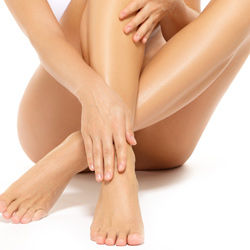
- Recovery of the perineal muscles, atrophied by the loss or decrease of muscle mass that usually takes place in the climacteric, with the decline of hormone production;
- Organic predisposition to muscle flaccidity, mainly with the loss of muscular tonus caused by normal deliveries;
- Improvement of sexual performance through vaginal narrowing;
- Unaesthetic or inefficient previous surgery;
- Aesthetic need for the correction of the labia minora and majora (improvement of their aged and shrunken look, making them more “padded” and youthful), and of scars caused by childbirth, traumas, illnesses or asymmetries, in order to recover a woman’s self-esteem;
- Clitoral enlargement: Just as the penis can be enlarged in its thickness and have its defects treated, the clitoris can also be enlarged with natural results.
GLUTEUS AUGMENTATION
The desire to improve one’s body contour through minimally invasive procedures has been increasingly frequent among patients seeking plastic surgery offices. In Brazil, there is a constant search for improving the contour of the buttocks in order to lift them and to make them more attractive.

The buttocks are a focus of sexuality, a symbol of femininity in the Brazilian beauty standards. With aging, the muscle mass of the gluteal area drops off, the skin sags, the muscles become flaccid, and the buttocks undergo ptosis (they droop).
As Bioplasty is performed at a muscle level, it fills the muscle, stimulates collagen formation, shapes and provides support, with immediate results which will not be distinguished from those long-suffering bodybuilding exercises, neither visually nor by palpation.
Patients with flaccidity, traumatic damage to the buttocks and suffering from congenital or acquired deformities can also be benefited by this procedure in order to achieve better definition and proportion to the buttock-waist-thigh segments.
Bioplasty can be a good alternative since it is an interactive cosmetic procedure in which the patient can get up, take a look at himself in the mirror, and interact with the practitioner during the procedure, without any surprises regarding the results.
The pain experienced following the procedure is similar to the muscle pain that some experience when they spend a long time without working out and start over again in an intensive and heavy way in a short period of time. This pain can be controlled with painkillers and stops in three or, at most, four days.
It is an outpatient cosmetic procedure performed with local anesthesia (the same used by dentists) in which the patient can walk or sit down soon afterwards, and most importantly, according to the world scientific literature, it has very low complications rates, when applied with a microcannula and a good quality product (in Brazil, it needs Anvisa approval), and performed by a competent professional who masters the technique. After the procedure, patient may walk away and do his daily activities with relative rest.
HIPS AND TROCHATERIC DEPRESSIONS
It is unanimously accepted that the size and shape of the buttocks play their role in the definition of a more attractive silhouette for women. If it were not so, the worldwide known and desired Brazilian Butt Lift (or just BBL) would not be a beauty reference standard in other countries.

In this body figure set, well-curved and abundant hips are a must. In a female body, this area is roundish and, together with the shoulders and breasts, highlights the waist to create the “hourglass-shaped” body or the “guitar-shaped” look.
Even though both male and female bone and muscular structures are similar, women, however, have a slightly broader pelvis, allowing more space for pregnancy and delivery contractions. Women, however, do not have the same fat distribution. The trochanteric depressions (the known hip bilateral “dips”) will be disguised with Bioplasty: it will reveal richer, more defined and better designed pelvis lines.
The feared “double-waist” bulges caused either by the excess of weight or the tightness of low-cut pants or panties, if indicated, can also be treated with Bioplasty. Without a surgery or prosthesis, Bioplasty gives you broader, fuller, firmer hips with a very natural consistency.
THIGHS
Whether it be for inherited traits, aging, both weight or fat loss, the best advantage for the patient is that Bioplasty performed in the thighs and calves increases or restores volume in a very natural way—by sight or touch—shaping the patient’s own muscles as if it were the result of exercise workout.

CALVES
The desire to achieve the perfect body may extend to areas such as the lower part of the legs, dissatisfaction of many patients who would like to have them with more defined lines and showing the “gym-toned” look, softening the disproportions when compared to the whole body, even after the frustration of not being able to reach the expected goal through training, may it be for physical makeup, muscular hypotrophy, polio sequelae or brain paralysis.
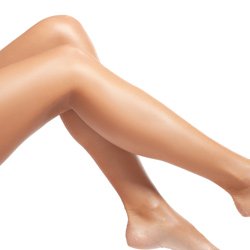
The purpose of the Bioplasty in the calves is to increase the size and shape of the gastrocnemii (the large posterior muscles which form the lower leg back bulge visible beneath the skin) in order to obtain natural curves as if by gym exercises.
Even patients who have bow legs, i.e., curved “outward”, may benefit from Bioplasty. It is an in-office procedure enabling the patient to go back his normal activities right afterwards.
It is recommended though that right after the procedure (a) patient wear knee-high compression stockings during the day and continue doing so as long as they feel comfortable (b) as well as that legs be kept elevated whenever possible.
SIX-PACK ABS
The definition of the abdominal muscles (resembling a six-pack of beverage cans) to show well-developed rounded muscle bellies can also be accomplished with Bioplasty. A flaccid abdomen for both men and women is not aesthetically pleasant.
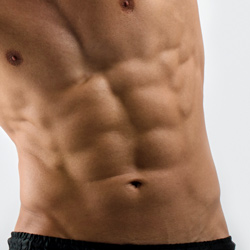
That is why the fitness industry has been paying more attention to exercises that develop the rectus abdominis. For those who are not patient or persistent to strive to achieve it with physical exercises, Bioplasty is a good alternative: men and women have been benefited with the well-shaped and designed “mounds” developed according to one’s muscular abdominal structure.
It is important to mention that in order to achieve a more apparent and satisfactory result, patient is to have both weight and fat percentage close to ideal, for the thinner the patient, the better and more visible the result.
CHEST
According to Exame magazine (Brazilian fortnightly publication specialized in economics, business, politics and technology), Brazilian fitness market, even facing a countrywide financial crisis, is worth US$ 2 billion annually. It is easy to understand why fitness centers have so much potential growth: the seek for the perfect body is aimed by men and women alike regardless the class, race or age.
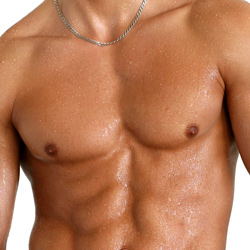
Mainly for men, the chest muscles receive special attention as they are considered a symbol of strength and maleness, not only for those who exhibit them but also for those who watch them. (So much so that many men have this area shaved or waxed so that it gets more noticeable.)
In order to have their expectations met, men undergo physical training and bodybuilding. Chest Bioplasty helps recover volume and aesthetic symmetry lost through aging and also helps those who have unproportioned chest compared to the rest of the body or those who cannot—or do not want to—enlarge their muscle size through bodybuilding.
There are still others who are not successful in achieving the desired result despite the strenuous physical exercise. And some never get there because of a physical condition that hinders the development of their chest muscles. Bioplasty also refers to not rare occurrences of people who suffer from a subnormal growth of the chest muscles or from Poland Syndrome (atrophy of the chest muscle), which leads to muscle asymmetry.
Most of these patients show serious psychological changes due to the irregular chest contours. In bone alterations, Bioplasty is especially corrective for congenital defects (those with which an individual is born) as Pectus excavatum and Pectus carinatum. In Pectus carinatum, the chest wall grows outwards, projecting the sternal bone and the ribs forward. This deformity is popularly known as “pigeon chest”. In Pectus excavatum, known as “funnel chest” or “sunken chest”, the chest wall grows inwards.
For both, the degree of severity ranges a lot. In most cases, the impairment is only aesthetic and rarely functional, and for the latter, Bioplasty is not indicated. It can be indicated after surgical treatment in order to complement a surgery, if necessary, for aesthetic improvement and correction of asymmetries or size.
Traditional surgery to correct both deformities is extremely invasive, complex and very expensive. Bioplasty can correct the irregular chest appearance without interfering with the function and the shape of the bones, promoting the desired aesthetic improvement.
There are rare cases of patients who have both deformities, that is, Pectus excavatum and Pectus carinatum. In either case, Bioplasty – may it be cosmetic or reconstructive – is a simple procedure, performed in the physician’s office with local anesthesia. The patient remains awake and can follow the ongoing process step by step and can go back to his daily activities on the same day.
ARMS
In patients in whom the muscles of the shoulders and arms are poorly developed, flaccid or asymmetrical, it is possible to augment the deltoids, biceps, triceps and any other muscle for which it is indicated, and as a result, the contours are defined and enlarged without the presence of the biomaterial being noticed.

The firmness is very similar to that achieved through bodybuilding. When Bioplasty is performed properly, it is virtually impossible to distinguish a size increase earned by working out from the size achieved by this procedure.
It is also widely used on patients who have lost a lot of weight or even those who, with the aging process, have loose skin and flaccidity in the triceps muscle in the posterior region of the arms, which becomes evident when the arm is extended, mainly during the “bat-wing” movement.
Bioplasty can help in this case by redesigning the contours, especially the triceps, as if there had been a lot of workout, through enlarging the muscle, improving the flaccidity and contours, plumping up and filling the flabby skin.
HANDS
In addition to the face, some of the most visible effects of the aging process are found in the hands. The skin on the dorsum of the hands is thin and has numerous transverse grooves. The composition of the subcutaneous tissue is loosely arranged and contains little fat.
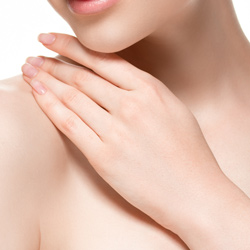
With the aging process, blood vessels and tendons form a network with loose subcutaneous tissue, fat decreases, and the back of the hands looks dented, aged (“shriveled” or “lean”), leaving vessels and tendons more evident, whose appearance can be improved by increasing the volume of the tissues, disguising veins and tendons, and bringing a more youthful appearance to the hands.
